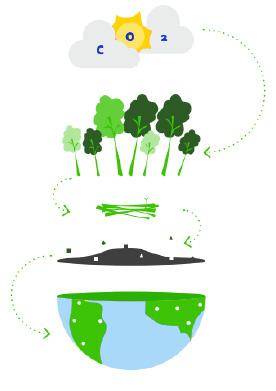Biochar – carbon removal for hundreds of years
February 6, 2024
Biochar and carbon credits from different project is still in its infancy but has a great potential. Partly because biochar has the ability to store carbon for hundreds of years and partly because of the benefits of its use as soil fertilizer.
Turning biomass into biochar is a useful way to store carbon for hundreds of years. Through a process called pyrolysis, biomass is burnt without oxygen, leading to the creation of biochar, alongside a bio-oil and a gas that can be used as fuel. The resulting biochar is up to 95% carbon and has a very low risk of reversal, meaning that carbon in the biochar is very unlikely to be returned to the atmosphere.
Puro is the standard we use for biochar projects and the carbon credits are called CO2 Removal Certificates, or CORCs. Founded in 2019, Puro has a science-based method that calculates the climate benefit of biochar projects, including the emissions associated with producing the biochar.
As biochar is an industry in its infancy, carbon credit sales are really helping it to scale. It is hoped that in the future, it can be sustained by just agricultural purchasing, without the support of carbon credits. But for the time being, it is economically unfeasible to create biochar without the support of the carbon market.
We can source biochar credits in Scandinavia, Europe or Globally, and each project has slightly different ways of working. For example, Scandinavian projects commonly use offcuts from the timber industry as their fuel stock and contribute to district heating systems. Alternatively, a project in Brazil uses purpose grown eucalyptus as the feedstock but has a focus on preserving the primary rainforest in the surrounding area.

The variety of sources of biomass is reflected in the variety of ways the resulting biochar is applied. It is often used in place of agricultural fertilizers due to the benefits biochar provides to soil health. Biochar was even used as the planting substrate to many trees around the city of Stockholm as it increases space for roots to grow compared with typical soils. This has allowed for more greenery in the urban area, supporting local ecosystem services from the growing trees and the gas produced during pyrolysis is used in the district heating network.
We can help find you the right project based on your requirements of volume, location and price.
Please contact ashley.farber@zeromission.se for more information.
/https%3A%2F%2Fzeromission.se%2Fwp-content%2Fuploads%2F2024%2F02%2Fbiokol-low.jpg)
/https%3A%2F%2Fzeromission.se%2Fwp-content%2Fuploads%2F2024%2F01%2FJJA3922-scaled-e1705582322558.jpeg)
/https%3A%2F%2Fzeromission.se%2Fwp-content%2Fuploads%2F2023%2F06%2FHH17636.jpeg)